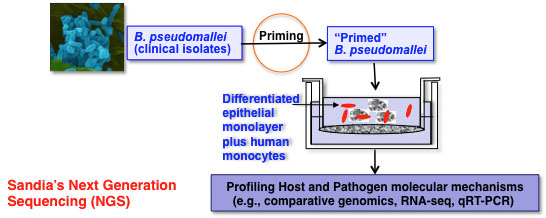Sahar El-Etr (15-ERD-017)
Abstract
We are exploring the use of a systems biology approach to identify and verify critical bacterial and host molecular mechanisms involved in human infection by the Burkholderia pseudomallei bacterial pathogen, thus establishing new targets for countermeasures against human melioidosis (also called Whitmore's disease) and a new strategy for target discovery that will be broadly applicable to bacterial infections. Because of its weaponization history, combined with its high potency in aerosol infection and resistance to many common antibiotics, B. pseudomallei is considered a Tier 1 select agent by the Centers for Disease Control and Prevention. We intend to develop a new approach to target discovery and verification using gene transcript capture, and next-generation sequencing techniques to analyze gene expression in both pathogen and host over the course of infection in a multicellular model of a human airway tissue. In parallel, we will use a targeted proteomics approach to identify host effector proteins secreted by the pathogen during infection, and detect their interactions with host proteins. These data will be used to build multiple-scale, temporal models of infection, enabling identification of molecular mechanisms and pathways in both pathogen and host that are critical for infection. We will then experimentally confirm some of the pathways predicted as critical for successful B. pseudomallei infection in vitro and in vivo.
We expect to identify and verify critical bacterial and host molecular mechanisms involved in human infection by B. pseudomallei. This strategy uses cutting-edge technologies to address technical roadblocks that have confounded previous biological host–pathogen interaction studies. Previously, laboratory-adapted strains of B. pseudomallei and mouse models of infection have been used in research that do not recapitulate the inflammation responses of humans. Our approach ensures relevance to humans through use of clinical rather than laboratory-adapted strains, human primary cells rather than immortalized cell lines, and hamster models rather than mice. We will identify gene expression changes indicating activation of the pathogen's metabolic and virulence pathways, as well as the host's defenses against the pathogen, at critical time points during infection. Computational models constructed from these gene expression data will be used to identify key genes and pathways to target for therapeutic intervention. Verification of target utility will be carried out through direct manipulation and characterization in several complementary models of infection of increasing complexity.
Mission Relevance
This research will establish an approach that enables accelerated identification of novel targets for countermeasures against a wide array of infectious agents, in support of the Laboratory's core competency in bioscience and bioengineering. By working at the intersection of host, pathogen, and environment, we expect to improve the understanding of complex disease mechanisms through experiment and simulation.
FY15 Accomplishments and Results
In FY15 we (1) standardized infections of primary epithelial cells and macrophage cells, as well as MatTek Corporation's EpiAirway tissue (in vitro human tracheal/bronchial tissue) with B. pseudomallei; (2) conducted pilot experiments for the infection of both primary cells and EpiAirway tissue with B. pseudomallei clinical and laboratory strains (see figure); (3) performed and analyzed the first deep-sequencing experiments with RNA isolated from the above experiments, (4) conducted deep-sequencing analyses of the clinical strains to be used; (5) began improving the annotation of the published reference B. pseudomallei genome; and (6) established protocols for the isolation and identification of secreted and surface B. pseudomallei proteins from infected host cells.






